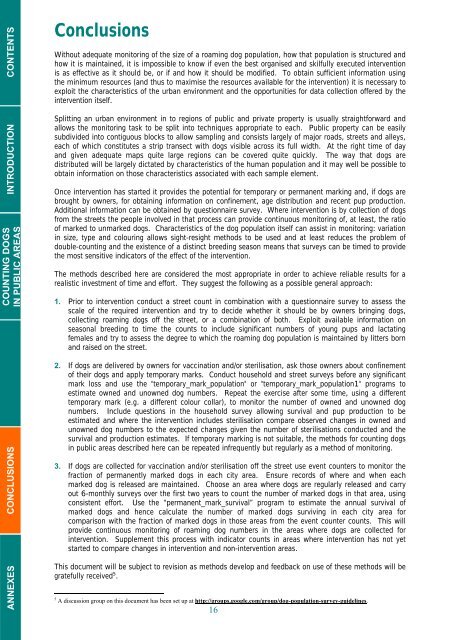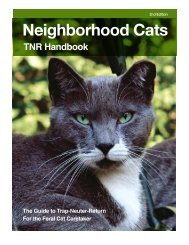Surveying roaming dog populations: guidelines ... - Animal Sheltering
Surveying roaming dog populations: guidelines ... - Animal Sheltering
Surveying roaming dog populations: guidelines ... - Animal Sheltering
You also want an ePaper? Increase the reach of your titles
YUMPU automatically turns print PDFs into web optimized ePapers that Google loves.
CONTENTS<br />
INTRODUCTION<br />
COUNTING DOGS<br />
IN PUBLIC AREAS<br />
CONCLUSIONS<br />
ANNEXES<br />
Conclusions<br />
Without adequate monitoring of the size of a <strong>roaming</strong> <strong>dog</strong> population, how that population is structured and<br />
how it is maintained, it is impossible to know if even the best organised and skilfully executed intervention<br />
is as effective as it should be, or if and how it should be modified. To obtain sufficient information using<br />
the minimum resources (and thus to maximise the resources available for the intervention) it is necessary to<br />
exploit the characteristics of the urban environment and the opportunities for data collection offered by the<br />
intervention itself.<br />
Splitting an urban environment in to regions of public and private property is usually straightforward and<br />
allows the monitoring task to be split into techniques appropriate to each. Public property can be easily<br />
subdivided into contiguous blocks to allow sampling and consists largely of major roads, streets and alleys,<br />
each of which constitutes a strip transect with <strong>dog</strong>s visible across its full width. At the right time of day<br />
and given adequate maps quite large regions can be covered quite quickly. The way that <strong>dog</strong>s are<br />
distributed will be largely dictated by characteristics of the human population and it may well be possible to<br />
obtain information on those characteristics associated with each sample element.<br />
Once intervention has started it provides the potential for temporary or permanent marking and, if <strong>dog</strong>s are<br />
brought by owners, for obtaining information on confinement, age distribution and recent pup production.<br />
Additional information can be obtained by questionnaire survey. Where intervention is by collection of <strong>dog</strong>s<br />
from the streets the people involved in that process can provide continuous monitoring of, at least, the ratio<br />
of marked to unmarked <strong>dog</strong>s. Characteristics of the <strong>dog</strong> population itself can assist in monitoring: variation<br />
in size, type and colouring allows sight-resight methods to be used and at least reduces the problem of<br />
double-counting and the existence of a distinct breeding season means that surveys can be timed to provide<br />
the most sensitive indicators of the effect of the intervention.<br />
The methods described here are considered the most appropriate in order to achieve reliable results for a<br />
realistic investment of time and effort. They suggest the following as a possible general approach:<br />
1. Prior to intervention conduct a street count in combination with a questionnaire survey to assess the<br />
scale of the required intervention and try to decide whether it should be by owners bringing <strong>dog</strong>s,<br />
collecting <strong>roaming</strong> <strong>dog</strong>s off the street, or a combination of both. Exploit available information on<br />
seasonal breeding to time the counts to include significant numbers of young pups and lactating<br />
females and try to assess the degree to which the <strong>roaming</strong> <strong>dog</strong> population is maintained by litters born<br />
and raised on the street.<br />
2. If <strong>dog</strong>s are delivered by owners for vaccination and/or sterilisation, ask those owners about confinement<br />
of their <strong>dog</strong>s and apply temporary marks. Conduct household and street surveys before any significant<br />
mark loss and use the "temporary_mark_population" or "temporary_mark_population1" programs to<br />
estimate owned and unowned <strong>dog</strong> numbers. Repeat the exercise after some time, using a different<br />
temporary mark (e.g. a different colour collar), to monitor the number of owned and unowned <strong>dog</strong><br />
numbers. Include questions in the household survey allowing survival and pup production to be<br />
estimated and where the intervention includes sterilisation compare observed changes in owned and<br />
unowned <strong>dog</strong> numbers to the expected changes given the number of sterilisations conducted and the<br />
survival and production estimates. If temporary marking is not suitable, the methods for counting <strong>dog</strong>s<br />
in public areas described here can be repeated infrequently but regularly as a method of monitoring.<br />
3. If <strong>dog</strong>s are collected for vaccination and/or sterilisation off the street use event counters to monitor the<br />
fraction of permanently marked <strong>dog</strong>s in each city area. Ensure records of where and when each<br />
marked <strong>dog</strong> is released are maintained. Choose an area where <strong>dog</strong>s are regularly released and carry<br />
out 6-monthly surveys over the first two years to count the number of marked <strong>dog</strong>s in that area, using<br />
consistent effort. Use the “permanent_mark_survival” program to estimate the annual survival of<br />
marked <strong>dog</strong>s and hence calculate the number of marked <strong>dog</strong>s surviving in each city area for<br />
comparison with the fraction of marked <strong>dog</strong>s in those areas from the event counter counts. This will<br />
provide continuous monitoring of <strong>roaming</strong> <strong>dog</strong> numbers in the areas where <strong>dog</strong>s are collected for<br />
intervention. Supplement this process with indicator counts in areas where intervention has not yet<br />
started to compare changes in intervention and non-intervention areas.<br />
This document will be subject to revision as methods develop and feedback on use of these methods will be<br />
gratefully received 5 .<br />
5 A discussion group on this document has been set up at http://groups.google.com/group/<strong>dog</strong>-population-survey-<strong>guidelines</strong>.<br />
16








